An estimated 5,000-plus came out for the bouts and there wasn’t a bad seat in the house.
From the 1930s on, the ringside view at Memorial Gym was just as intimate as the birds-eye view from the second deck, where fans gazed almost directly down on the canvas floor that Idaho’s leather-pushers treaded for more than 20 years.
The atmosphere was second to none. So was the boxing.
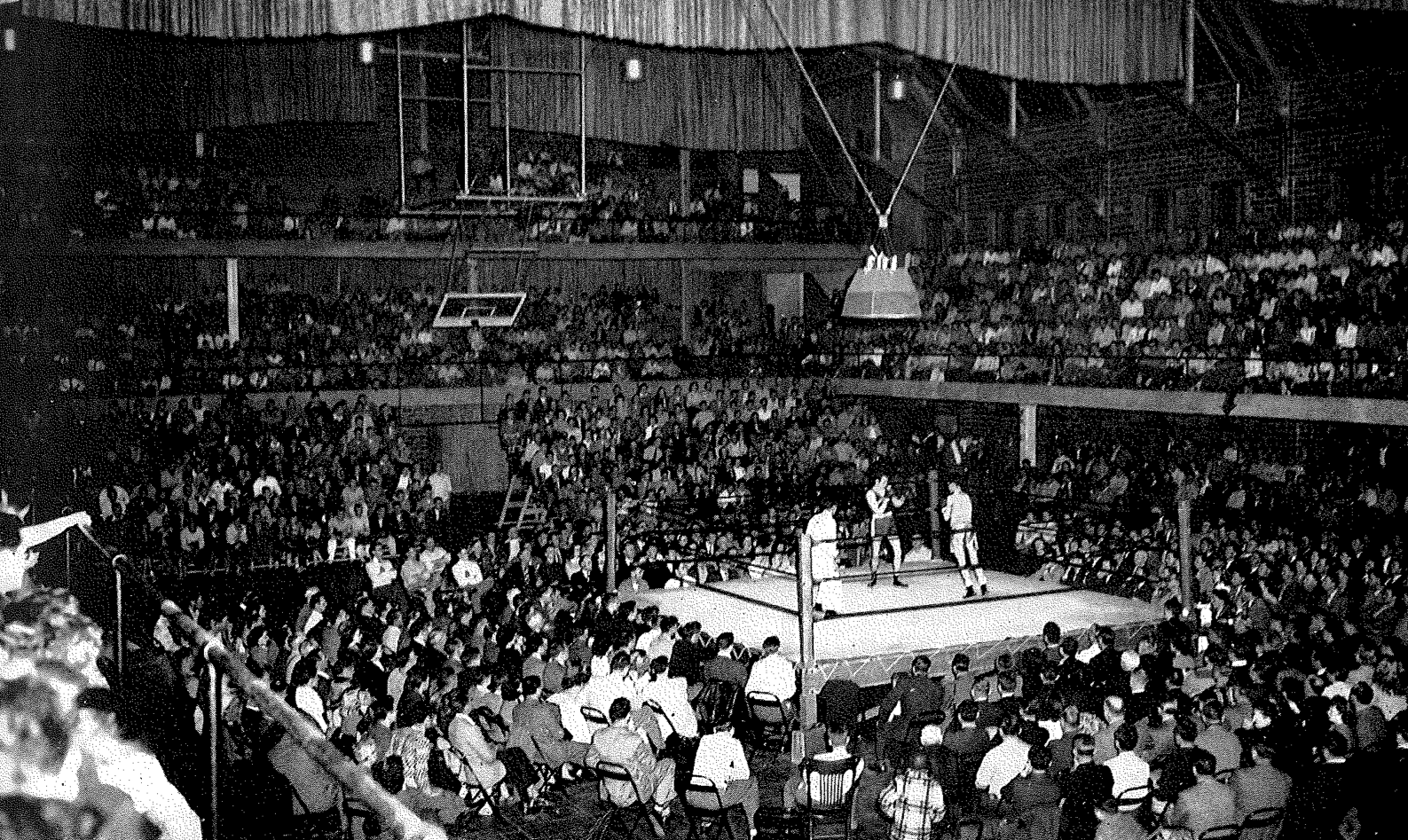
More than 5,200 fans packed Memorial Gym in the 1930s, 40s and 50s to watch Idaho’s best boxers spar. The teams collected 19 total national championships. Courtesy photos | UI
(For a full gallery of UI boxing photos, use this link to redirect to our Facebook page: https://www.facebook.com/media/set/?set=a.10152184938982982.1073741876.244185562981&type=1)
Before the NCAA discontinued it in 1954, the sport had somewhat of a haven in Moscow, where boxers flocked to compete for the likes of coaches Frank Young and Bob Knox.
They came to the University of Idaho from small logging communities in Northern Idaho, mining towns in Southern Idaho and farming communities in Eastern Washington. They left with bruises, scars and broken bones — and with Pacific Coast Championships galore.
There were national titles as well. Armfuls of them.
And though UI put an end to the national brand that had been created by national champions Herb Carslon, Ted Kara and Laune Erickson, the legacy of Vandal boxing lived long past its demise in 1953.
The house that Louie built
It was a college student from Spokane who introduced boxing to Idaho.
“When a young fellow, with a last name like the eighth month of the year, registered as a student at the University,” wrote former UI president Donald Theophilus in a biography dedicated to Louis August, known more commonly as Louie.
August, eager for an opportunity to teach the sport at his new home, introduced a boxing club in 1932, just three years shy of the school’s first individual national championship.
With the approval of then Director of Athletics Leo Calland, August placed an ad in The Argonaut, and boxing at UI was born.
Three students came out to train with August, who had a Pacific Coast AAU championship to his name already. By February 1933, the crop had grown by 22. After a successful exhibition fight drew 500 fans, August sought out local competition and Washington State College, less than 10 miles away in Pullman, seemed a perfect fit.
The border rivals sparred against one another for about 20 years and there was no doubt the Palouse boasted a couple of the nation’s top clubs.
“It hadn’t been a world shaking beginning, but the first blows had been struck and boxing at Idaho was here to stay,” Theophilus wrote.
The club had initially been funded by the physical education department but in 1934, was moved to ASUI’s payroll. That spring, WSU coach Isaac Deeter suggested to August that his club transition to a full-fledged collegiate program.
In many ways, Deeter was a catalyst for this UI boxing project, which would transform into something much more meaningful down the road.
“Ike (Deeter), in my opinion, is the dean of boxing coaches nationally,” late 1940s Idaho coach Frank Young told the Spokesman-Review in a 1998 article.
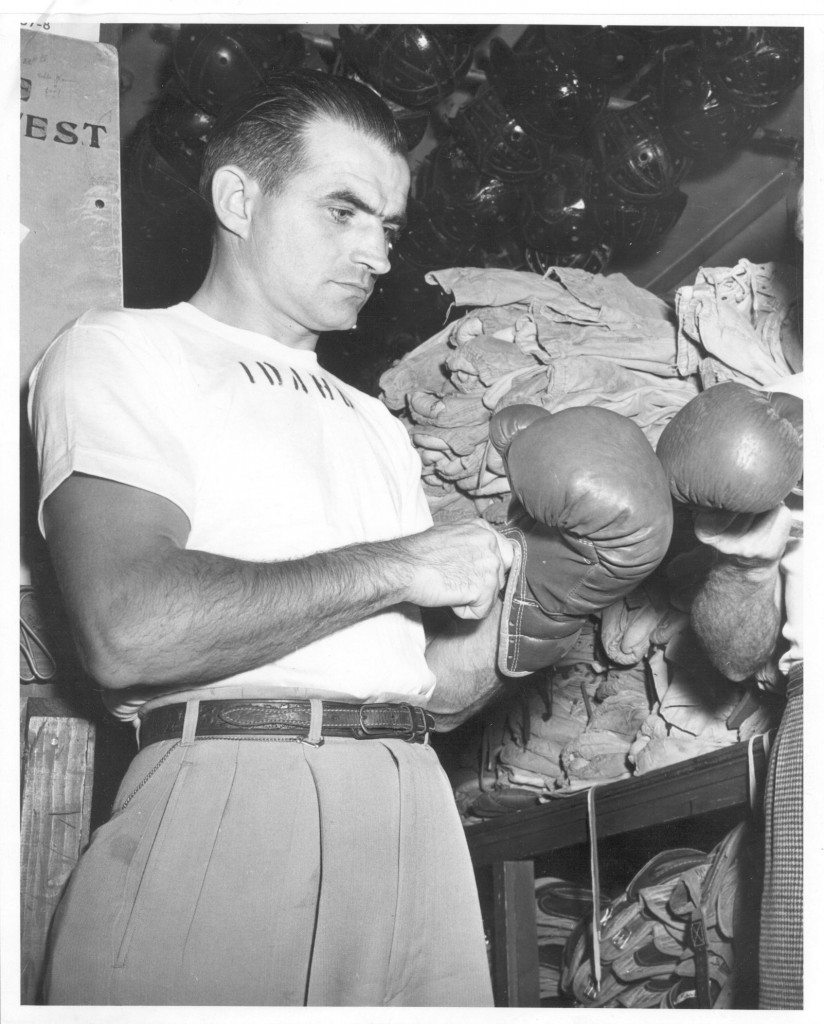
Ex-Idaho coach Frank Young took the job in 1948 and coached boxers like Herb Carlson, Frank Echevarria and Laune Erickson during his tenure. Courtesy | UI
A national power indeed.
At Idaho, boxing was labeled a “minor sport” by the university. However, August and his squad had major potential and the buzz that the Vandal ringmen created had the attention of high school boxers statewide.
“They’d come in from all the little logging towns,” Young told the Spokesman. “Loggers loved that boxing.”
Idaho’s sluggers hailed from all over the state and especially in Moscow’s bordering towns — Kamiah, Grangeville and Potlatch to name a few. The townspeople would bus to Memorial Gym to support their local boxers.
Idaho’s first Pacific Coast title came by way of Louie Denton, who claimed the 145-pound championship.
It’d be three more years before the school won another Pacific Coast Conference championship, but the program moved forward nonetheless. August was signed to a coaching deal that equated to $750 per year, and in 1937 the coach fielded his first eight-man team.
He was well worth the money.
August’s boxer, Rolly Shumway, won the school’s first ever national title at 145 pounds in 1937, and Julian “Bud” Benoit was victorious in a 135-pound national bout a year later.
The Argonaut wrote about the team’s triumphs at both the PCC and national tournaments: “Loaded with honors are Coach Louie August’s fighting Vandals after their invasion of California and Virginia … Benoit returned to the Idaho campus, not only with a shiny 8-inch copper trophy with a figure of a boxer, but with a big gold medal …”
More than just the glistening hardware they were bringing home, the era in which the Vandal ringmen were thriving in was just that for one of the nation’s booming programs — golden.
Ted Kara: Idaho’s “biggest gun”
It wasn’t uncommon for the nation’s top swingers to crack the Olympic boxing scene and find success while doing so.
This caliber of athlete came few and far between, but Theodore “Ted” Kara was one of them. While the Olympic gold wasn’t in his forecast — he reached the 1936 Games in Berlin, but never won — Kara was as dominant as they came at the collegiate level.
Ted and brother Frank were at the heart of a group that would later earn the university’s first team national championship.
As a sophomore, Ted Kara was “the big gun in the attack once again,” according to Theophilus, and won the 127-pound title. He’d be the first boxer in the history of the NCAA to win three consecutive individual titles, after dropping down to the 120-pound weight class to claim back-to-back titles his junior and senior years.
Thousands upon thousands flocked to the highly anticipated Memorial Gym bouts, which pitted Idaho against national powers like San Jose State, WSU and Gonzaga.
However, Idaho was still seeking another measure of respect. August’s boys got it in 1940, when the team was awarded “major ‘I’ sweaters.”
The sport had paled in comparison to football, basketball and baseball, which were labeled “major sports” by the university. The boxing team was the next to earn the honor — fitting for a squad earning as much respect nationally as it was in the state of Idaho.
The Vandals compiled heaps of national championships as both Kara brothers, Laune Erickson and John Webster combined to win seven individual titles between 1939 and 1941.

Ted Kara, recognized as the best Vandal boxer to date, won three individual national championships while at UI and he and brother Frank made up the core of Idaho’s 1940 and 1941 national championship teams. Courtesy | UI
Proclaimed the best all-around team in the country, Idaho snapped up team titles in 1940 and 1941.
It would be six more years before the Vandals were recipients of another national crown. The team temporarily disbanded for three years due to World War II, but August and the Kara brothers had created something that wasn’t going to die on its own.
The next generation of Idaho leather-pushers made sure of that.
Recollections of the late ’40s and early ’50s
Frank Echevarria, 84, still savors many of the memories he had fighting under coach Frank Young, who replaced Ken Butler in 1948.
There was the first blow he took in the practice ring.
“Norman (Walker) was a big contender and I was real conscious and real, kind of, sort of apprehensive and scared and he hit me in the chest and I couldn’t even breathe but I didn’t let him know it,” said Echevarria, who currently lives in Blackfoot, Idaho.
Echevarria boxed for Idaho from 1948-1952. Then there was the rivalry with San Jose State’s Manuel “Mac” Martinez. Martinez was the creme de la creme at 125 pounds as the defending national champion. The boxers’ history dictated that Martinez was someone Echevarria just “had to beat.”
The fighter out of Blackfoot, Idaho, came out tense and Martinez topped him in a split decision. They met again in the PCC Championships and Echevarria returned with a fresh game plan.
“He was kind of a slugger type, so I thought ‘by God, I’ll beat him at his own game,'” he said.
Echevarria was not cut from the same cloth as Martinez. The smaller boxer, who resorted to boxing in high school, rather than football or basketball because of his small stature, was more adept to winning the mental battles in the ring and outthinking his opponent.
When the third go-around came in the next PCC championship tournament, Echevarria finally had his night.
“And everything worked my way that night and I beat him,” Echevarria said. “It was the highlight of my career.”
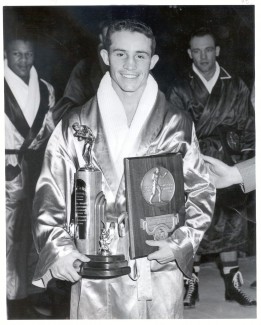
Frank Echevarria holds his national championship trophy and the LaRowe Trophy, which was given annually to the nation’s best boxer. Echevarria now lives in Blackfoot, Idaho. Courtesy | UI
The teams in the late ‘40s were just as lethal, if not more so, than those of August’s when the Kara brothers donned Idaho’s satin robes.
The Walker brothers, Len (Leonard) and Norm, from the mining town of Wallace led these squads. Len laid claim to a couple of national championships (1949 at 135 and 1950 at 145) and Norm was a national runner-up.
“When the going got tough, those guys got going. They grew up fighting,” Echevarria recalled. “They didn’t walk away from a fight either. Whether it was in the bar or in the ring, it didn’t matter to them.”
The other Wallace native on Young’s roster was Herb Carlson, one of just nine boxers in NCAA history who would earn at least three national championships.
He may not have been at Ted Kara’s level, but Carlson held his own in the ring, and at three separate weight classes too.
Some would argue he was the best to ever bounce around the Mem Gym ring.
“What made him special is that nobody could beat him,” Echevarria said. “He was Idaho’s best.”
Len Walker, Carlson, Laune Erickson and Echevarria won six national titles in the post-WWII era and Echevarria has Idaho’s last — a 1952 title in the 119-pound division. He earned the LaRowe Trophy the same year, given annually to the best collegiate boxer in the nation.
Idaho boxing was in its prime and MemGym was more of a sardine can when hoards of fans traveled from across the state to get a glimpse of Young’s club.
“We’d get as many people as we would for football and more than for basketball,” said Young, who has passed away since interviewing with the Spokesman-Review in 1998. “The fire marshal was always raising hell.”
The last jabs
Though a national discontinuation of the sport at the collegiate level was in the works, Idaho’s concerns about boxing’s presence at the university came in 1954.
“Spectators should come to a sports contest expecting to watch a demonstration of skill and spirit,” Theophilus wrote upon his decision to drop the sport. “Too many spectators come to a boxing match hoping to see someone hurt. Every precaution was taken to protect the collegiate boxer, but I was always afraid that spectators hoping to see destructive force in the ring might be satisfied.”
Sixteen individual national titles, three national team titles and 24 total PCC crowns later, the abolition of Idaho boxing was complete. Six years later, the NCAA closed up shop after a Wisconsin boxer was killed in the ring.
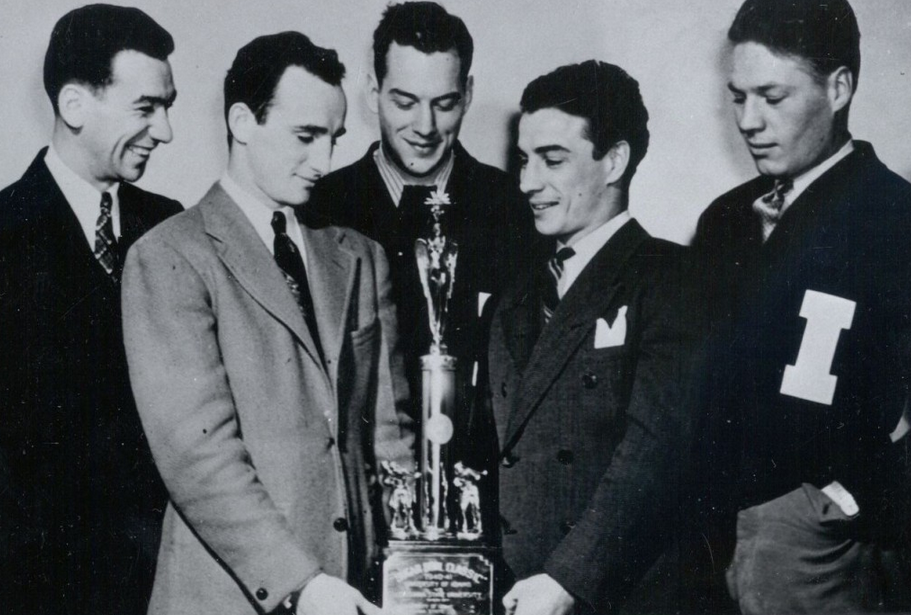
Coach Louie August, Ted Kara, Chase Anderson, Frank Kara and Laune Erickson hold the Sugar Bowl trophy in 1941. What was originally a club sport created by August, Idaho won 19 national championships, before the sport was discontinued in 1954.
All but a few of the Idaho ringmen have passed on.
Echevarria, meanwhile, lives in his hometown of Blackfoot,Idaho, with his longtime wife Norma. The boxer who once utilized savvy mind games to outsmart opponents, hasn’t won as many battles since parting ways with the sport.
Echevarria hardly watches the sport on television anymore, but that may not be by his own choice.
“My wife hates it. Now she doesn’t like it because, like she said, it’s the kickboxing … that’s not boxing,” Echevarria said. “She has control of me, pretty much.”
One of Idaho’s nine national champions, Echevarria still speaks highly of his four years in Moscow — a period he calls “the best years of my life.”
Echevarria developed a liking for boxing in high school, only to love the sport by the time he fought in front of his first Memorial Gym crowd.
“There’s a soft spot in my heart for the University of Idaho, because it was really good to me and great for me,” Echevarria said. “I was really enthusiastic about it, because that was the only thing I had that was good for me. And it was good for a lot of guys, not just me.”

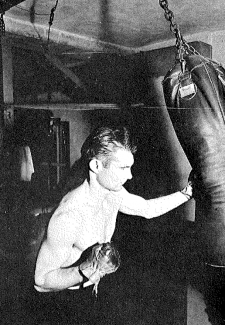
dennis wanamaker
Very interesting. I would be interested in the history of high school boxing in North Idaho. My uncles boxed for St. Maries in the 40's.